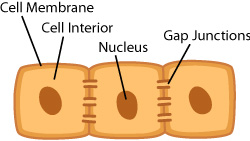Epithelial Cells line the cavities of the body and cover the body. Epithelial cells come in a variety of shapes, including squamous epithelial, cuboidal epithelial, and culumnar epithelial. In addition to these shapes, epithelial cells can be described as being simple or stratified. Simple contains one layer while stratified contains multiple. (EC) Our skin is made up of epithelial cells.
Here are the different types of epithelial cells.

Below is the structure of an epithelial cell. It differs from eukaryotic cells because it only contains a cell membrane, cell interior, and nucleus that a eukaryotic cell has. Epithelial cells have gap junctions, but eukaryotic cells don't.

Epithelial Cells are very complex cells and many functions that help the body function properly. For example, they help transport nutrients from one place in the body to the other. They also help guard against microbes. They are found in the lungs, skin, airway, and digestive tract. They also secrete the enzymes in the stomach. Moreover, all the functions of epithelial cells are protection, absorption, secretion, transportation, and filtration. (ET) Epithelial cells are classified as epithelial tissues. The cells functions depend on where they are found in the body. According to AboutHealth , "epithelial cells represent our first line of defense against pathogens that can enter out bodies through our airways, digestive tracts, and bloodstreams."
